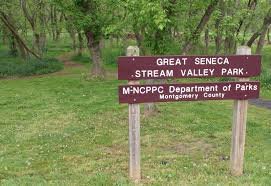Seneca Creek Greenway Trail
 Seneca Creek in Seneca, Montgomery County was initially envisioned by a famous international environmental advocate (Milt Kaufman) in 1944, He was responsible for organizing several non-profit organizations to help in the construction of this historic trail. These are the Seneca Valley Sugar Loafers Volksmarch Club, Village Outreach Volunteers, Mountain Club of Maryland, American Hiking Society, and Audubon Naturalist Society.
Seneca Creek in Seneca, Montgomery County was initially envisioned by a famous international environmental advocate (Milt Kaufman) in 1944, He was responsible for organizing several non-profit organizations to help in the construction of this historic trail. These are the Seneca Valley Sugar Loafers Volksmarch Club, Village Outreach Volunteers, Mountain Club of Maryland, American Hiking Society, and Audubon Naturalist Society.
Seneca Creek,
which is curbed within the Potomac Rocks, pumps out Piedmont in Central Maryland. Rocks along Seneca Creek are structurally composite because these were faulted and folded several times. The Inlet is fed by several rivers that surround Parr’s Ridge which is divided by slate barriers bending from Damascus to Laytonsville. Seneca’s major stream plunges to almost 300 feet. Based on the Maryland National Capital Park and Planning Commission, Seneca Creek covers more than 82,000 acres which is roughly 28 percent of Montgomery County. Information from the Commission revealed that Seneca basin has 72 miles of stream channels and regular flow rate of 62 million gallons daily measured at Route 28.
The name, Seneca Creek comes from the Seneca Indian tribe which is native to Maryland and the western portion of New York. For, more than 150 years, Seneca Creek together with other rivers in this County was the source of power for early settlers. The selling point of Middle Brook Mills in 1795 was Seneca Creek. It was described then as the most powerful and consistent stream in Montgomery. The County owned 44 mills prior to the 1800s and eight of these facilities were on Seneca Creek. The oldest was at Seneca Ford near the mouth of the river. By 1806, Montgomery had more than 50 such mills.
However, the land eventually started to deteriorate forcing settlers to head out for richer terrain in neighboring Kentucky and Tennessee. It was only when the Metropolitan Branch of the Baltimore and Ohio Rail Road was opened that farming became lucrative again. This was the time that fertilizers were used to a massive extent. These grist mills continued to be productive until the early 1900s. Unfortunately, the enterprise declined after 1925. Seneca Creek used to be the commerce hub for farmers in Montgomery. At present, it is noted for its historical and recreational values. The trail way is used by thousands of hikers, horseback riders, bikers, and bird watchers.
Enjoy your trip to Seneca and for a comfortable ride, make sure to call Affinity!

